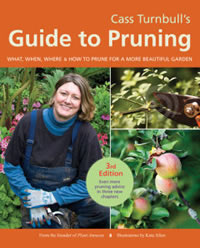A list of the best books, articles and websites on pruning and tree care.
Keyword: Pruning
Plant Amnesty
“PlantAmnesty’s mission is to end the senseless torture and mutilation of trees and shrubs.”
Garden Tip #395
Wondering when is it necessary to clean or sterilize your pruning tools, and how to do it? Washington State University Extension horticulturist Linda Chalker-Scott offers excellent “how-to” advice. Make sure there is no excess dirt or debris on your pruners before you clean them. There are quite a few impractical or inadvisable methods (formalin? chlorine bleach? no!); her preference is to use ordinary household cleaners.
Another factsheet discusses when to sterilize your tools. Chalker-Scott says that first you must know which pathogen is causing the disease. Then,
- “if it’s a virus or viroid, disinfect your tools.
- if it’s a vascular fungus or bacteria, and/or forms oozing cankers, disinfect your tools. Avoid cutting active, oozing cankers; wait until they dry.
- if you are pruning irreplaceable plants, disinfect your tools.
- choose a disinfectant treatment that has been shown to be effective through published research; I would probably not use alcohol but one of the common household cleaners at full strength.”
Garden Tip #79
Use the right tool for the job. Bypass pruners (with blades arranged like scissors) make the cleanest cut. Anvil pruners may feel more powerful, but the blade tends to crush small branches, leaving a jagged wound more vulnerable to rot. But anvil pruners are essential if wrists are weak. If bypass pruners aren’t working it’s time to move up to a lopper or a pruning saw. For a concise discussion of all the various pruning tools go to: http://www.hort.purdue.edu/ext/pruningtools.html
Garden Tip #15
A common question gardeners have is when to prune. “When the shears are sharp!” is the often-heard answer. In reality there are a few timing guidelines that do matter.
First of all, certain trees are known to “bleed” when pruned while the sap is rising in late winter and early spring. Maples, dogwoods, birch, elm, walnut and honey locust are the most common.
Bleeding usually won’t hurt the tree, but the pruning cuts are slower to heal which may leave susceptible trees vulnerable to infection. These trees should be pruned right after leaves fall off in autumn.
Cherry trees are at risk from the destructive cherry bark tortrix. The tortrix is attracted to fresh pruning cuts, so cherry trees should not be pruned between May and August when the tortrix is active.
Spring flowering shrubs should be pruned immediately after flowering so that the new growth has time to form next year’s flower buds. Summer flowering shrubs may be pruned in winter because flowers are formed on this season’s growth.
Pruning resources online:
- A guide to pruning trees and shrubs from University of Minnesota Extension
- A Google search of “pruning” limited to .edu sites (Cooperative Extensions links)
Garden Tip #178
American Horticultural Society Pruning and Training. Christopher Brickell, editor. New York: DK publishing. 1996
This book gives detailed instructions on how and when to prune trees, shrubs, fruit trees, vines and roses. With good basic background information on general pruning techniques, pruning guesswork is eliminated. The book also explains how to do specialized methods of training like turning your hedge into a living sculpture.
Guide to Pruning
 Cass Turnbull needs no introduction to our readers and a new book by her is a cause for celebration. Her “Guide to Pruning” is now available in its 3rd edition with three added chapters, including a much needed essay on Taming the Native-Plant Garden. She also addressed an impressive list of new plants not considered in the earlier editions, including “whackables” such as Lavatera and Perovskia. Oh, how I wish I had read about the dangers of whacking too soon–before making my mid-February cutbacks in my own garden.
Cass Turnbull needs no introduction to our readers and a new book by her is a cause for celebration. Her “Guide to Pruning” is now available in its 3rd edition with three added chapters, including a much needed essay on Taming the Native-Plant Garden. She also addressed an impressive list of new plants not considered in the earlier editions, including “whackables” such as Lavatera and Perovskia. Oh, how I wish I had read about the dangers of whacking too soon–before making my mid-February cutbacks in my own garden.
Excerpted from the Spring 2013 Arboretum Bulletin.